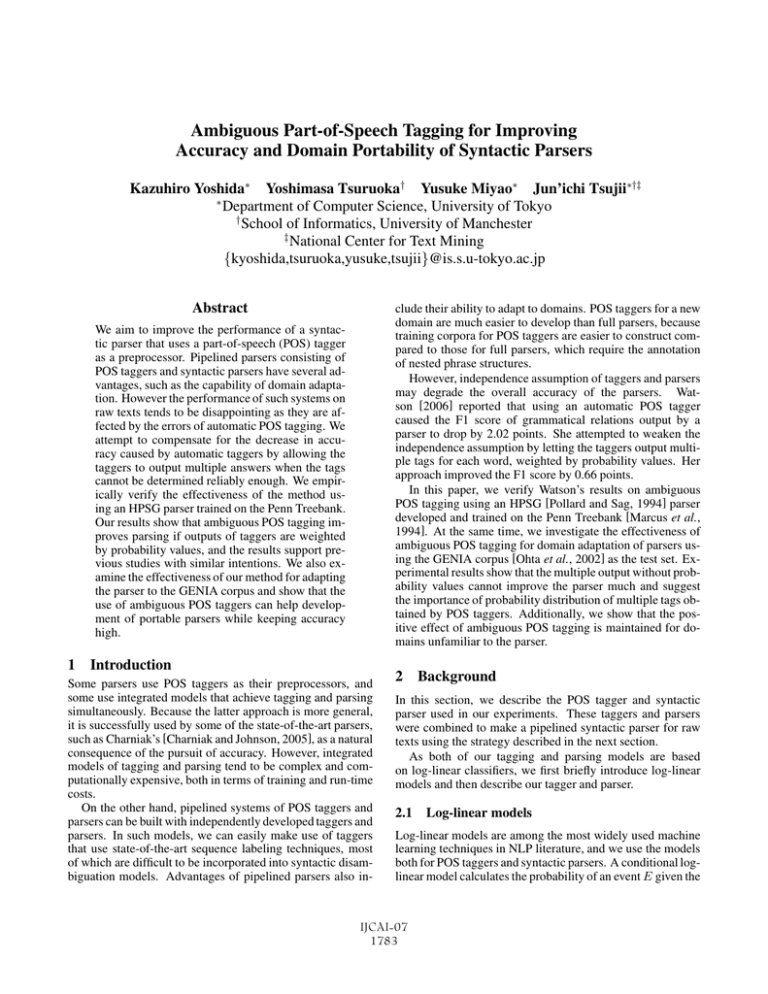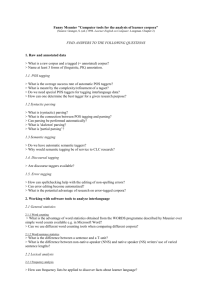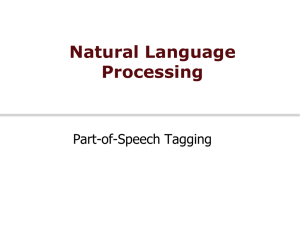Ambiguous Part-of-Speech Tagging for Improving
advertisement

Ambiguous Part-of-Speech Tagging for Improving
Accuracy and Domain Portability of Syntactic Parsers
Kazuhiro Yoshida∗ Yoshimasa Tsuruoka† Yusuke Miyao∗ Jun’ichi Tsujii∗†‡
∗
Department of Computer Science, University of Tokyo
†
School of Informatics, University of Manchester
‡
National Center for Text Mining
{kyoshida,tsuruoka,yusuke,tsujii}@is.s.u-tokyo.ac.jp
Abstract
clude their ability to adapt to domains. POS taggers for a new
domain are much easier to develop than full parsers, because
training corpora for POS taggers are easier to construct compared to those for full parsers, which require the annotation
of nested phrase structures.
However, independence assumption of taggers and parsers
may degrade the overall accuracy of the parsers. Watson [2006] reported that using an automatic POS tagger
caused the F1 score of grammatical relations output by a
parser to drop by 2.02 points. She attempted to weaken the
independence assumption by letting the taggers output multiple tags for each word, weighted by probability values. Her
approach improved the F1 score by 0.66 points.
In this paper, we verify Watson’s results on ambiguous
POS tagging using an HPSG [Pollard and Sag, 1994] parser
developed and trained on the Penn Treebank [Marcus et al.,
1994]. At the same time, we investigate the effectiveness of
ambiguous POS tagging for domain adaptation of parsers using the GENIA corpus [Ohta et al., 2002] as the test set. Experimental results show that the multiple output without probability values cannot improve the parser much and suggest
the importance of probability distribution of multiple tags obtained by POS taggers. Additionally, we show that the positive effect of ambiguous POS tagging is maintained for domains unfamiliar to the parser.
We aim to improve the performance of a syntactic parser that uses a part-of-speech (POS) tagger
as a preprocessor. Pipelined parsers consisting of
POS taggers and syntactic parsers have several advantages, such as the capability of domain adaptation. However the performance of such systems on
raw texts tends to be disappointing as they are affected by the errors of automatic POS tagging. We
attempt to compensate for the decrease in accuracy caused by automatic taggers by allowing the
taggers to output multiple answers when the tags
cannot be determined reliably enough. We empirically verify the effectiveness of the method using an HPSG parser trained on the Penn Treebank.
Our results show that ambiguous POS tagging improves parsing if outputs of taggers are weighted
by probability values, and the results support previous studies with similar intentions. We also examine the effectiveness of our method for adapting
the parser to the GENIA corpus and show that the
use of ambiguous POS taggers can help development of portable parsers while keeping accuracy
high.
1 Introduction
Some parsers use POS taggers as their preprocessors, and
some use integrated models that achieve tagging and parsing
simultaneously. Because the latter approach is more general,
it is successfully used by some of the state-of-the-art parsers,
such as Charniak’s [Charniak and Johnson, 2005], as a natural
consequence of the pursuit of accuracy. However, integrated
models of tagging and parsing tend to be complex and computationally expensive, both in terms of training and run-time
costs.
On the other hand, pipelined systems of POS taggers and
parsers can be built with independently developed taggers and
parsers. In such models, we can easily make use of taggers
that use state-of-the-art sequence labeling techniques, most
of which are difficult to be incorporated into syntactic disambiguation models. Advantages of pipelined parsers also in-
2 Background
In this section, we describe the POS tagger and syntactic
parser used in our experiments. These taggers and parsers
were combined to make a pipelined syntactic parser for raw
texts using the strategy described in the next section.
As both of our tagging and parsing models are based
on log-linear classifiers, we first briefly introduce log-linear
models and then describe our tagger and parser.
2.1
Log-linear models
Log-linear models are among the most widely used machine
learning techniques in NLP literature, and we use the models
both for POS taggers and syntactic parsers. A conditional loglinear model calculates the probability of an event E given the
IJCAI-07
1783
Input: Sentence s
Output: Tag sequence t1 , . . . tn
Algorithm:
1. foreach ti do ti := NULL
2. foreach ti = NULL
Compute probability distribution
P (ti |ti−2 , ti−1 , ti+1 , ti+2 , s) (1)
by log-linear models
3. Let i be easiest place to tag in
ti := (Most probable tag for ti )
4. repeat 2 and 3 until
ti = NULL for each i
the HPSG grammar is a combination of two log-linear models.
The first log-linear model is for selecting lexical entries for
words of a POS-tagged sentence, which estimates the probability
P (li |wi , ti ),
where wi , ti , and li represent an ith word, POS tag, and lexical entry in a sentence, respectively. The information of wi
and ti are used in combination as features of the log-linear
model.
The second model is for selecting the most probable parse
from an HPSG parse forest F which is constructed from lexical entries that are weighted by the first model:
Figure 1: Algorithm for POS tagging
P (T |l1,...,n , w1,...,n , t1,...,n ),
condition C as follows:
exp( i λi fi (E, C))
,
P (E|C) =
ZC
where T ∈ F . The overall disambiguation model is
where the real-valued functions fi are used to indicate useful features for predicting E, parameters λi are optimized
to fit the model to the training data, and ZC is a normalization constant. Several criteria for estimating the parameters of log-linear models exist, and we used MAP estimation
with Gaussian prior distribution [Chen and Rosenfeld, 1999],
which is most commonly and successfully applied in various
NLP tasks.
2.2
POS tagger
We employ the bidirectional inference model proposed by
Tsuruoka et al. [2005] for our POS taggers. The model consists of 16 log-linear models, each of which provides the
probability
P (ti |ti−2 , ti−1 , ti+1 , ti+2 , s),
(1)
where s is a given sentence, and ti is the POS tag for the ith
word. An algorithm used by the POS taggers is shown in Figure 1. The key idea of the algorithm is that it does not work
in the usual left-to-right manner, instead it iteratively tries to
tag words that can be tagged most easily. “Easiness” of tagging is measured by the highest probability value among the
probability distribution of the tags. When we calculated Eq.
1 in step 2 of the algorithm, each from ti−2 , ti−1 , ti+1 , ti+2
could be NULL, so we prepared 24 = 16 classifiers to cover
every pattern of the appearances of NULL. Each token in a
training corpus was used as training data for all 16 classifiers.
The features used by the classifiers were the surface strings of
words, base forms of words obtained by a dictionary, prefixes
and suffixes, and POSs of already tagged words.
Though the algorithm described above is totally deterministic, a slight modification with beam search strategy could
make it output an approximation of k-best tag sequences with
probability values.
2.3
(2)
Grammar and parser
The parser we used is based on Head-Driven Phrase Structure Grammar (HPSG), which was developed using the Penn
Treebank [Miyao et al., 2004]. The disambiguation model for
argmax P (T |w1,...,n , t1,...,n ) =
T ∈F
argmax P (T |l1,...,n , w1,...,n , t1,...,n )
P (li |wi , ti ).
T ∈F
i
The parsing algorithm for the disambiguation model is a
CYK-like chart parsing with iterative beam search [Ninomiya
et al., 2005].
3 Combining POS taggers and parsers
In pipelined parsers, POS taggers and syntactic parsers are
developed separately, and we can freely change taggers for
parsers, without any special care for the algorithms. To make
pipelined systems of ambiguous POS taggers and parsers
work the same way, we restrict the interface of ambiguous
taggers and formalize the condition of the syntactic disambiguation models that can be applied to the output of ambiguous taggers without modification.
We concentrate on the following situation: for each word
in a sentence, POS taggers output a set of candidate POS tags,
and the obtained tags are used to restrict parses in the parsing
model.
In our experiments, we compared the following three types
of taggers.
single The single tagger outputs the most probable single
tag for each word.
multi The multi tagger outputs a set of candidate POS tags
for each word.
prob The prob tagger is similar to multi, but each POS tag is
weighted by its probability. That is, it provides the probability
distribution P (tij |S), where S is an input sentence and tij
represents the jth candidate POS tag of the ith word.
We assume that the parsing model consists of two independent models: terminal and non-terminal. A parse T of a given
sentence S consists of the terminal structure T t and nonterminal structure T nt , and terminal and non-terminal models
IJCAI-07
1784
are used to estimate the probability distributions P (T t |S) and
P (T nt |T t , S). The best parse is given by
LP/LR
87.12/86.71
argmax P (T nt , T t |S) =
Table 1: Accuracy on section 22 with correct POS tags
T nt ,T t
nt
t
F1
86.91
t
argmax P (T |T , S)P (T |S).
T nt ,T t
Then, we assume that the terminal structure T t can be further decomposed into a sequence of terminal labels li , . . . , ln ,
where the label li corresponds to the ith word of the sentence,
and terminal labels are independent of one another in the terminal model:
P (li |S).
P (T t |S) =
i
The overall disambiguation model becomes
argmax P (T nt |l0 , . . . , ln , S)
P (li |S).
T nt ,T t
(3)
i
We assume that a tractable estimation method and disambiguation algorithm applicable to Eq. 3 exist.
Let us then rewrite the distribution P (li |S) to make it dependent on outputs of POS taggers, so that we can incorporate
the information of POS tags into the parsing model.
P (tij , S)P (li |tij , S),
(4)
P (li |S) =
j
where tij is the jth element of a set of POS tags assigned to
the ith word of the sentence, and P (tij , S) is the probability
of that tag calculated by the prob tagger (multi and single taggers can be integrated into the model similarly by assuming
the tags assigned to the same word by the taggers are equally
probable). By replacing P (li |S) that appears in Eq. 3 with
Eq. 4, we can apply the same disambiguation algorithm as
Eq. 3 to the combined system of an ambiguous POS tagger
and the parsing model.
This strategy is applicable to a wide range of grammars and
disambiguation models including PCFG, where the terminal
model is used to assign POS tags to words and lexicalized
grammars such as HPSG, where the terminal model assigns
lexical entries to words. The HPSG parser described in Section 2.3 is straightforwardly adapted to this model, by taking
Eq. 2 as a terminal model.
One problem with this strategy is the increased ambiguity
introduced by multiple tags. As reported by Watson [2006],
the increase in computational costs can be suppressed by applying appropriate parsing algorithms. The parsing algorithm
we used [Ninomiya et al., 2005] is suitable for such purposes,
and we will show experimentally that the disambiguation of
the above model can be performed with efficiency similar to
models with single taggers.
3.1
Implementation of prob tagger
There can be various methods for implementing the prob tagger described above. Our implementation outputs approximation of tag probabilities by marginalizing the probability
of k-best tag sequences obtained by the algorithm described
in Section 2.2.
To control the ambiguity of the tagger, we introduce a parameter θ which is used to threshold the candidate tags. If the
marginalized probability of a candidate tag is smaller than the
probability of the best tag of the same word multiplied by θ,
the candidate is discarded.
Figure 2 illustrates example outputs of each tagger from
the 3 best analysis of the sentence, “Mr. Meador had been
executive vice president of Balcor,” without thresholding.
Marginalization of probability distribution output by POS
taggers loses information about the sequential dependency of
tags, which can harm the performance of the parser. For example, let us consider the sentence, “Time flies like an arrow.”
When there are two candidate POS tag sequences “NN VBZ
IN DT NN” and “VB NNS IN DT NN,” the output of multi
tagger will be “{NN, VB} {VBZ, NNS} IN DT NN,” which
can induce a tag sequence “VB VBZ IN DT NN” that is not
included in the original candidates.
4 Experiments
The first experiment verified the effect of ambiguous POS
tagging using the Penn Treebank for both training and testing. The second experiment examined the parser’s capability
of domain adaptation, using the Penn Treebank for training
the parser, biomedical texts for training the tagger, and the
GENIA corpus for testing.
Both experiments used the same HPSG grammar and
parser. The grammar was developed using the Penn Treebank
sections 02-21, and the disambiguation model was trained
on the same data. The accuracy of the parser evaluated on
the Penn Treebank section 221 using the correct POS tags is
shown in Table 1. Labeled precision (LP) and labeled recall (LR) are the precision and recall of dependencies with
predicate-argument labels, and F1 is the harmonic mean of
LP and LR. Each dependency between a pair of words is
counted as one event. These measures were also used in the
following experiments. The figures in Table 1 can be considered the practical upper bounds, because they are not affected
by incorrect predictions of POS taggers. (We will refer to the
results using the correct POS tags as gold.) In the following, comparisons of the systems were performed using the F1
scores.
4.1
Parsing Penn Treebank
The POS taggers described in this section were trained on the
Penn Treebank sections 00-18, and the performance of the
tagger on the development set was 96.79%. As described
in Section 3.1, our taggers multi and prob have a hyperparameter θ for controlling the number of alternative answers
1
Following the convention of literature on Penn Treebank parsing, we used section 22 for development, and section 23 for the final
test.
IJCAI-07
1785
Input
3 best sequences
(probability)
single
multi
prob
(probability)
Mr
NNP
NN
NNP
NNP
{NNP, NN}
NNP(0.925)
NN(0.075)
Meador
NNP
NN
NNP
NNP
{NNP, NN}
NNP(0.925)
NN(0.075)
had
VBD
VBD
VBD
VBD
VBD
VBD
been
VBN
VBN
VBN
VBN
VBN
VBN
executive
JJ
JJ
NN
JJ
{JJ, NN}
JJ(0.955)
NN(0.045)
vice
NN
NN
NN
NN
NN
NN
president
NN
NN
NN
NN
NN
NN
of
IN
IN
IN
IN
IN
IN
Balcor
NNP
NNP
NNP
NNP
NNP
NNP
.
.
.
.
.
.
.
(0.879)
(0.075)
(0.046)
Figure 2: Example of tagging results
multi θ = 0.1
multi θ = 0.01
multi θ = 0.001
multi θ = 0.0001
prob θ = 0.1
prob θ = 0.01
prob θ = 0.001
prob θ = 0.0001
LP/LR
85.24/84.68
84.13/83.64
79.29/78.68
71.01/70.36
85.26/84.73
85.28/84.88
85.19/84.80
85.08/84.60
F1
84.96
83.88
78.98
70.68
84.99
85.08
84.99
84.84
# of training data
300
1000
3000
Table 2: Accuracy with different θ
10000
39832
(all)
LP/LR
F1
63.63/36.57
62.51/35.43
61.46/39.62
75.21/68.41
73.84/66.33
73.56/68.10
81.72/78.94
79.97/77.42
79.90/78.34
85.35/84.32
83.50/82.09
83.47/82.59
87.12/86.71
85.26/84.72
85.28/84.88
46.45
45.23
48.18
71.65
69.88
70.72
80.31
78.67
79.11
84.83
82.79
83.03
86.91
84.99
85.08
Table 3: Accuracy with different sizes of training data
87
86
85
84
F1
included in the output, where a smaller θ means a larger number of alternative answers. Before comparing ambiguous taggers (i.e., multi and prob) with single, we first determined
which of multi and prob and which value of θ perform best.
The performance of the parser for various θ is shown in
Table 2. The parsers with the multi tagger was outperformed
by prob in all cases2 , so we only used the prob tagger in the
following experiments. The performance of the parser with
the prob tagger has a peak around θ = 0.01. The accuracy
slowly decreases for smaller θs, the reason for which might
be the problem noted in the last paragraph of Section 3.1. We
used the best performing θ (= 0.01) in the following experiments.
It was interesting to see whether the contribution of ambiguous tagging changed according to the performance of
the syntactic disambiguation model, because if ambiguous
POS tagging did not work well with a poorer disambiguation
model, ambiguous tagging could be considered not to help
the performance in domains unfamiliar for the parser, where
the performance of the disambiguation model was likely to
be lower. We observed a change in performance of the parser
when the number of sentences used for developing the grammar and for training the syntactic disambiguation model was
changed. Table 3 shows the performance of the parser trained
with various numbers of sentences selected from the Penn
Treebank sections 02-21. Figure 3 shows F1 scores of the
systems trained on 3000, 10000, and 39832 sentences.
Ambiguous POS tagging with the prob tagger could be
contended to contribute to the performance of the parser, because the performance of the parser with the prob tagger was
consistently better than that of the single tagger in all of the
Tagging
strategy
gold
single
prob
gold
single
prob
gold
single
prob
gold
single
prob
gold
single
prob
83
82
81
gold
single
prob
80
79
78
5000
10000
15000
20000
25000
30000
Figure 3: F1 of different sizes of training data
gold
single
prob
LP/LR
F1
86.91/86.28
84.41/83.80
85.24/84.89
86.59
84.10
85.06
mean
parsing
time
739 msec
785 msec
936 msec
2
Actually, multi has a negative effect, compared with the results
of single shown in the ’all’ row of Table 3, which has an F1 score of
84.99.
IJCAI-07
1786
35000
# of sentences
Table 4: Accuracy on test set
40000
POS tagger
LP/LR
F1
gold
single-Penn
prob-Penn
single-BIO
prob-BIO
83.21/81.57
76.84/76.48
78.48/78.11
81.75/80.65
82.60/81.44
82.38
76.66
78.29
81.20
82.02
mean
parsing
time
845 msec
799 msec
950 msec
803 msec
873 msec
so significant.
In summary, we showed that the adaptation of POS taggers
can significantly improve the performance of parsers in new
domains, and the use of ambiguous POS tagging can extend
the improvement further.
5 Related Work
Table 5: Accuracy on GENIA
above experiments if evaluated in the F1 measure. With the
entire training data used for the development of the parser,
the contribution of ambiguous POS tagging was about 0.093.
Table 4 summarizes the performance of some of our systems
evaluated using section 23 of the Penn Treebank. The overall
tendency observed on the development set remained, but the
contribution of ambiguous tagging was considerably bigger
than in the development set.4 As can be seen from the table,
prob was the slowest of all, but the difference is not so big.
This may be because Ninomiya’s method of HPSG parsing,
which outputs the first answer found, worked tolerantly to increase of ambiguity.
4.2
Parsing GENIA corpus
One of the most crucial advantages of separating POS tagging
from syntactic parsing is that the domain adaptation of such
systems can be partly achieved by just changing POS taggers. In this section, we verify that the effect of ambiguous
POS tagging is also remains for domains with which parsing
models are not familiar.
The test data we used was the GENIA treebank [Tateisi et
al., 2005], which annotates Penn Treebank-style tree structures to sentences of the GENIA corpus. The GENIA corpus
consists of the abstracts of biomedical papers adopted from
MEDLINE [Campbell et al., 1997]. We trained our POS tagger with the mixture of the WSJ part of the Penn Treebank,
the Penn BioIE corpus [Kulick et al., 2004], and the GENIA
corpus, which consist of 38219, 29422, and 18508 sentences,
respectively. Following Hara et. al. [2005], we adopted 50
abstracts (467 sentences) for the evaluation. Performance of
the single tagger on these sentences was 98.27%.
The result is shown in Table 5. single-Penn and prob-Penn
are single and prob taggers trained on the Penn Treebank, and
single-BIO and prob-BIO are those trained on the biomedical
domain (i.e., the Penn BioIE corpus and the GENIA corpus).
Compared to the results with gold POS tags, the use of automatic taggers trained on a different domain degraded the performance by about 4 to 5 points in the F1 measure. This drop
was recovered using well-tuned taggers, and remarkably, the
results of prob-BIO were only 0.36 points lower than the upper bound.5 The difference in processing time was, again, not
3
Though this figure alone seems not to be significant, we will
show that the results of the same experiment using the test set have
significant improvements.
4
The improvement of prob over single is significant with p <
10−4 according to stratified shuffling tests [Cohen, 1995].
5
The improvement, in terms of recall, of prob over single is sig-
Charniak et al. [1996] investigated the use of POS taggers that
output multiple tags for parsing and concluded that single taggers are preferable, because the accuracy of the tag sequences
selected by parsers did not improve significantly, while the increase in computational cost is considerable. Watson [2006]
revisited the same task and observed that in terms of the accuracy of parsing, multiple taggers improve the performance
significantly. Our results show that the taggers should pass to
the parser not only multiple answers, but also probability values for each candidate. Watson’s results also imply that appropriate parsing strategies can make the increase of computational cost not as problematic as Charniak et al. suggested.
Our results again agree with Watson’s at this point.
Clark et al. [2004] introduced supertaggers that output
multiple supertag candidates, and the taggers were used as
a front end of their CCG parser. Because the training of supertaggers require corpora more deeply annotated than POS
tagged ones, their method should have difficulties if we exploit taggers for domain adaptation.
Adaptation of general parsers to a biomedical domain has
already attracted several researchers. Because the biggest difference between general English and biomedical literature
is their vocabularies, use of lexical resources and tools is a
natural approach. Lease et al. [2005] modified Charniak’s
parser [1999] to make it conform to GENIA’s tagging convention and made use of biomedical dictionaries to restrict
the parser output. They obtained an impressive error reduction of 14.2% and expected that further improvement is possible using named-entity recognizers.
We can see that the performance shown in Section 4.2
is significantly lower than those in 4.1. This suggests that
changing POS taggers can only partially achieve domain
adaptation, so we should consider training syntactic disambiguation models on the target domain if we desire further
improvement. This is what Hara et al. [2005] explored, and
their results suggested that a small number of in-domain data
could bring considerable improvements of the performance if
out-of-domain data was as large as the Penn Treebank. Because their evaluation was done with POS tagged sentences,
whether this is still the case for the task of parsing raw texts
is an open question
6 Conclusion
In this paper, we demonstrated that the accuracy of parsers
could be improved by allowing POS taggers to output multiple answers for some words. When the performance of the
parser was evaluated in terms of precision/recall of predicate
argument relations, the performance of the parser with the
nificant with p < 10−4 according to stratified shuffling tests. The
improvement of precision is not significant.
IJCAI-07
1787
ambiguous POS tagger consistently outperformed that with
the conventional unambiguous tagger throughout the experiments, and this was also the case for a domain that was not
used to train the parser. If the goal is to optimize the accuracy
of predicate-argument structures, we can say ambiguous tagging is profitable, and introducing ambiguous tagging without
harming the capability of domain adaptation is possible.
One apparent deficiency of our system is that it cannot take
into account the dependencies among outputs of the POS taggers. Perhaps we can achieve further improvement by running separate parsing processes for each candidate POS sequence that is output by the POS tagger, but this approach
might not be acceptable considering computational cost.
References
[Campbell et al., 1997] K. Campbell, D. Oliver, and
E. Shortliffe.
The Unified Medical Language System: Toward a Collaborative Approach For Solving
Terminological Problems, 1997.
[Charniak and Johnson, 2005] E. Charniak and M. Johnson.
Coarse-to-Fine n-Best Parsing and MaxEnt Discriminative
Reranking. In Proc. of the 43rd Annual Meeting of the Association for Computational Linguistics (ACL’05), pages
173–180, June 2005.
[Charniak et al., 1996] Eugene Charniak, Glenn Carroll,
John Adcock, Anthony R. Cassandra, Yoshihiko Gotoh,
Jeremy Katz, Michael L. Littman, and John McCann. Taggers for Parsers. Artificial Intelligence, 85(1-2):45–57,
1996.
[Charniak, 1999] Eugene Charniak. A Maximum-EntropyInspired Parser. Technical Report CS-99-12, 1999.
[Marcus et al., 1994] Mitchell P. Marcus, Beatrice Santorini,
and Mary Ann Marcinkiewicz. Building a Large Annotated Corpus of English: The Penn Treebank. Computational Linguistics, 19(2), 1994.
[Miyao et al., 2004] Yusuke Miyao, Takashi Ninomiya, and
Jun’ichi Tsujii. Corpus-oriented Grammar Development
for Acquiring a Head-driven Phrase Structure Grammar
from the Penn Treebank. In Proc. of IJCNLP-04, 2004.
[Ninomiya et al., 2005] Takashi Ninomiya, Yoshimasa Tsuruoka, Yusuke Miyao, and Jun’ichi Tsujii. Efficacy
of Beam Thresholding, Unification Filtering and Hybrid
Parsing in Probabilistic HPSG Parsing. In Proc. of IWPT
2005, pages 103–114, 2005.
[Ohta et al., 2002] Tomoko Ohta, Yuka Tateisi, Hideki
Mima, and Jun’ichi Tsujii. GENIA Corpus: an Annotated
Research Abstract Corpus in Molecular Biology Domain.
In Proceedings of the Human Language Technology Conference (HLT 2002), March 2002.
[Pollard and Sag, 1994] Carl Pollard and Ivan A. Sag. HeadDriven Phrase Structure Grammar. The University of
Chicago Press, 1994.
[Tateisi et al., 2005] Yuka Tateisi, Akane Yakushiji, Tomoko
Ohta, and Jun’ichi Tsujii. Syntax Annotation for the GENIA corpus. In Proceedings of the IJCNLP 2005, Companion volume, pages 222–227, October 2005.
[Tsuruoka and Tsujii, 2005] Yoshimasa
Tsuruoka
and
Jun’ichi Tsujii. Bidirectional Inference with the EasiestFirst Strategy for Tagging Sequence Data. In Proceedings
of HLT/EMNLP 2005, pages 467–474, 2005.
[Watson, 2006] R. Watson. Part-of-speech Tagging Models
for Parsing. In Proc. of CLUK 2006, 2006.
[Chen and Rosenfeld, 1999] S. Chen and R. Rosenfeld. A
Gaussian prior for smoothing maximum entropy models.
In Technical Report CMUCS, 1999.
[Clark and Curran, 2004] Stephen Clark and James Curran.
The importance of supertagging for wide-coverage CCG
parsing. In 20th International Conference on Computational Linguistics, 2004.
[Cohen, 1995] Paul R. Cohen. Empirical methods for artificial intelligence. MIT Press, Cambridge, MA, USA, 1995.
[Hara et al., 2005] Tadayoshi Hara, Yusuke Miyao, and
Jun’ichi Tsujii. Adapting a probabilistic disambiguation
model of an HPSG parser to a new domain. In Natural Language Processing IJCNLP 2005, volume 3651 of
Lecture Notes in Artificial Intelligence. Springer-Verlag
GmbH, 2005.
[Kulick et al., 2004] S. Kulick, A. Bies, M. Liberman,
M. Mandel, R. McDonald, M. Palmer, A. Schein, and
L. Ungar. Integrated annotation for biomedical information extraction. In Proc. of HLT/NAACL 2004, 2004.
[Lease and Charniak, 2005] Matthew Lease and Eugene
Charniak. Parsing Biomedical Literature. In IJCNLP,
pages 58–69, 2005.
IJCAI-07
1788




